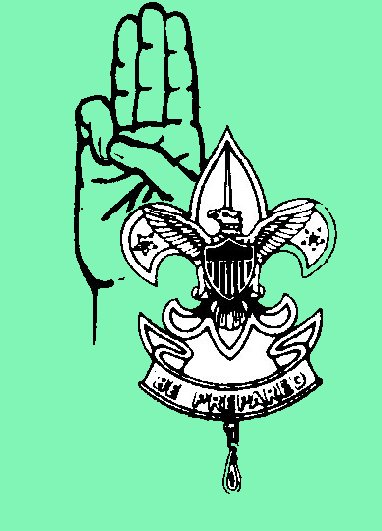
![]()
AIMS
|
Boy Scouting works towards three aims. One is growth in moral strength and character. We may define this as what the boy is himself; his personal qualities, his values, his outlook.
A second is participating citizenship. Used broadly, citizenship means the boy's relationship to others. He comes to learn obligations to other people, to the society he lives in, and to the government that presides over that society.
A third aim of Boy Scouting is development of physical, mental, and emotional fitness. Fitness includes the body (well-tuned and healthy), the mind (able to think and solve problems), and the emotions (self-control, courage, and self-respect).
The methods are designed to accomplish these aims. Thus it is important that you know and use the methods of Boy Scouting. Other methods are good, but they may bring different results -- results quite different than we are seeking.
![]()
|
Scouting provides a series of surmountable obstacles and steps to overcome them through the advancement method. The Scout plans his advancement and progresses at his own pace as he overcomes each challenge. The Scout is rewarded for each achievement, which helps him gain self-confidence. The steps in the advancement system help a boy grow in self-reliance and the ability to help others.
The ideals of Scouting are spelled out in the Scout Oath, Law, motto, and slogan. The Scout measures himself against these ideals and continually tries to improve. The goals are high, and as he reaches for them he has some control over what he becomes.
The patrol method gives Scouts an experience in group living and participating citizenship. It places a certain amount of responsibility on young shoulders and teaches boys how to accept it. The patrol method allows Scouts to act in small groups where they easily can relate to each other.These small groups determine troop activities through their elected representatives.
Boy Scouting is designed to take place outdoors. It is in the outdoors that Scouts share responsibilities and learn to live with each other. It is here that the skills and activities practiced at troop meetings come alive with purpose.
Being close to nature helps Scouts gain an appreciation for God's handiwork and mankind's place in it. The outdoors is the laboratory for Scouts to learn ecology and practice conservation of nature's resources.
Boys learn from the examples set by their adult leaders. Troop leadership may be male or female, and association with adults of high character is encouraged at this stage of a young man's development.
As Scouts plan their activities, and progress towards their goals, they experience personal growth. The Good Turn concept is a major part of the personal growth method of Scouting. Boys grow as they participate in community service projects and do Good Turns for others. There probably is no device so successful in developing a basis for personal growth as the daily Good Turn.
The religious emblems program is also a large part of the personal growth method. Frequent conferences with his Scoutmaster help each Scout to determine growth toward Scouting's aims.
Boy Scouting encourages boys to learn and practice leadership skills. Every Scout has the opportunity to participate in both shared and total leadership situations. Understanding the concepts of leadership helps a boy accept the leadership roles of others and guides him toward the citizenship aim of Scouting.
The uniform makes the Scout troop visible as a force for good and creates a positive youth image in the community. Boy Scouting is an action program, and wearing the uniform is an action that shows each Scout's commitment to the aims and purposes of Scouting. The uniform gives the Scout identity in a world brotherhood of youth who believe in the same ideals.
The uniform is practical attire for Scout activities, and provides a way for Scouts to wear the badges that show what they have accomplished.
![]()
On my honor I will do
my best
To do my duty to God and my country
and to obey the Scout Law;
To help other people at all times;
To keep myself physically strong,
mentally awake, and morally straight.
![]()
Trustworthy
Loyal
Helpful
Friendly
Courteous
Kind
Obedient
Cheerful
Thrifty
Brave
Clean
Reverent
![]()
Scout Motto |
Scout Slogan |
| Be Prepared | Do a Good Turn Daily |
![]()
As an American,
I will do my best to-
Be clean in my
outdoor manners,
Be careful with fire,
Be considerate in the outdoors,
and
Be conservation-minded.
![]()
PREDICTIONS
For every 100
boys who join a Boy Scout troop:
|